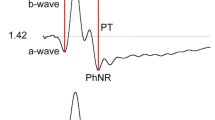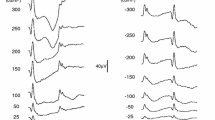Abstract
Results from studies of human subjects suggest that the multifocal ERG technique developed by Erich Sutter and colleagues has considerable potential for assessment of retinal function in both the clinic and laboratory. While the utility of this measure depends to a large extent upon an understanding of the physiological origin for the different response components, relatively little is known in this regard. For the experiments described in this report, we made ERG recordings using both multifocal and conventional methods. Intravitreal injections of APB, PDA, and TTX were used to identify contributions from activity in ON pathway, OFF pathway, and third order retinal neurons, respectively. The results show that photoreceptor activity makes a small direct contribution to 1st and 2nd order multifocal photopic luminance responses. TTX-sensitive activity in third order retinal neurons contributes to both 1st and 2nd order responses with relatively greater contribution to the 2nd order response. Blockade of TTX-sensitive activity in third order cells produces effects on the 2nd order response which are very similar to changes observed in eyes suffering selective loss of retinal ganglion cells resulting from experimental glaucoma. Effects of these intravitreally injected test agents were also determined, in the same recording session, for flash, 30 Hz flicker, and oscillatory potential responses.
Similar content being viewed by others
References
Awatramani G, Wang J, Slaughter M. Amacrine and ganglion cell contributions to the electroretinogram in amphibian retina. Visual Neuroscience, 18: 2001; 147–156
Barnes S, Werblin F. Gated currents generate single spike activity in amacrine cells of the tiger salamander retina. Proc. Nat. Acad. Sci. 1986; 83: 1509–1512.
Barnes S, Hille B. Ionic channels of the inner segment of tiger salamander cone photoreceptors. J. General Physiol. 1989: 94: 719–743.
Bloomfield SA., Dowling JE. Roles of aspartate and glutamate in synaptic transmission in rabbit retina. I. Outer plexiform layer. J. Neurophysiol. 1985; 53: 699–713.
Bloomfield SA, Dowling JE. Roles of aspartate and glutamate in synaptic transmission in rabbit retina. II. Inner plexiform layer. J. Neurophysiol. 1985; 53: 714–725.
Bloomfield SA. Effect of spike blockade on the receptive field size of amacrine and ganglion cells in the rabbit retina. J. Neurophysiol. 1996; 75: 1878–1893.
Boos R, Schneider H, Wassle H. Voltage-and transmitter-gated currents of AII-amacrine cells in a slice preparation of the rat retina. J. Neurosci. 1993; 13: 2874–2888.
Bush RA, Sieving PA. A proximal retinal component in the primate photopic ERG a-wave. Investigative Ophthalmology & Visual Sci., 1994; 35: 635–645.
Bush RA, Sieving PA. Inner retinal contributions to the primate photopic fast flicker electroretinogram. J. Optical Soc. Am. 1996; 13: 557–565.
Chao TI, Pannicke T, Reichelt W, Reichenbach A. Na+ channels are expressed by mammalian retinal glial (Muller) cells. Neuroreport, 1993; 4: 575–578.
Cohen ED, Miller RF. The role of NMDA and non-NMDA excitatory amino acid receptors in the functional organization of primate retinal ganglion cells. Visual Neurosci., 1994; 11: 317–332
Cook PB, Lukasiewicz PD, McReynolds JS. Action potentials are required for the lateral transmission of glycinergic transient inhibition in the amphibian retina. J. Neurosci., 1998; 18: 2301–2308.
Dacheux RF, Raviola E. The rod pathway in the rabbit retina: a depolarizing bipolar and amacrine cell. J. Neurosci. 1986; 6: 331–345.
Dick E, Miller RF. Light-evoked potassium activity in mudpuppy retina: its relationship to the b-wave of the electroretinogram. Brain Research, 1978; 154: 388–394.
Dolan RP, Schiller PH. Evidence for only depolarizing rod bipolar cells in the primate retina. Visual Neurosci., 1989; 2: 421–424.
Dong C-J, Hare WA. Contribution to the kinetics and amplitude of the electroretinogram b-wave by third-order retinal neurons in the rabbit retina. Vision Res. 2000; 40: 579–589.
Famiglietti EV Jr, Kolb H. A bistratified amacrine cell and synaptic circuitry in the inner plexiform layer of the retina. Brain Res., 1975; 84: 293–300.
Hare WA, Owen WG. Spatial organization of the bipolar cell's receptive field in the retina of the tiger salamander. J. Physiol. (London), 1990; 421: 223–245.
Hare WA, Owen WG. Effects of 2-amino-4-phosphonobutyric acid on cells in the distal layers of the tiger salamander's retina. J. Physiol. (London), 1992; 445: 741–757.
Hare WA, Owen WG. Similar Effects of carbachol and dopamine on neurons in the distal retina of the tiger salamander. Visual Neurosci. 1995; 12: 443–55.
Hare W, WoldeMussie E, Ton H, Feldmann B, Wijono M, Ruiz G. Electrophysiological and histological measures of retinal injury in chronic ocular hypertensive monkeys. Investigative Ophthalmology & Visual Sci. (Suppl), 1998; 39: S493.
Hare W, Ton H, WoldeMussie E, Ruiz G, Feldmann B, Wijono M. Electrophysiological and histological measures of retinal injury in chronic ocular hypertensive monkeys. European Journal of Ophthalmology (Suppl). 1999; 9: S30–S33.
Hare W, Ton H, Ruiz G, Feldmann B, Wijono M, WoldeMussie E. Characterization of Retinal Injury Using ERG Measures Obtained with both Conventional and Multifocal Methods in Chronic Ocular Hypertensive Primates. Investigative Ophthalmology & Visual Sci. 2001; 42: 127–36.
Hensley SH, Yang X, Wu SM. Identification of glutamate receptor subtypes mediating inputs to bipolar cells and ganglion cells in the tiger salamander retina. J. Neurophysiol. 1994; 69: 2099–107.
Hille B. Common mode of action of three agents that decrease the transient change in sodium permeability in nerves. Nature (London), 1966; 210: 1220–2.
Hood DC, Seiple W, Holopigian K, Greenstein V. A comparison of the components of the multifocal and full-field ERGs. Visual Neurosci. 1999; 14: 533–44.
Hood DC, Frishman LJ, Viswanathan S, Robson JG, Ahmed J. Evidence for a ganglion cell contribution to the primate electroretinogram (ERG): Effects of TTX on the multifocal ERG in macaque. Visual Neurosci. 1999a; 16: 411–16.
Hood DC, Greenstein V, Frishman L, Holopigian K, Viswanathan S, Seiple W, Ahmad J, Robson JG. Identifying inner retinal contributions to the human multifocal ERG. Vision Res. 1999b; 39: 2285–91.
Hood DC. Assessing retinal function with the multifocal technique. Prog Retinal and Eye Res. 2000; 19; 607–46.
Ishida AT. Regenerative sodium and calcium currents in goldfish retinal ganglion cell somata. Vision Res. 1991; 31: 477–85.
Jardon B, Yucel H, Bonaventure N. Glutamatergic separation of ON and OFF retinal channels: possible modulation by glycine and acetylcholine. European J. Pharmacol. 1989; 162: 215–24.
Kaneko A, Tachibana M. A voltage-clamp analysis of membrane currents in solitary bipolar cells dissociated from Carassius auratus. J. Physiol. (London), 1995; 358: 131–152.
Karschin A, Wassle H. Voltage-and transmitter-gated currents in isolated rod bipolar cells of rat retina. J. Neurophysiol. 1990; 63: 860–76.
Kline RP, Ripps H, Dowling JE. Generation of b-wave currents in the skate retina. Proc. Nat. Acad. Sci. 1978; 75: 5727–31.
Knapp AG, Schiller PH. The contribution of ON-bipolar cells to the electroretinogram of rabbits and monkeys. Vision Res. 1984; 24: 1841–46.
Lasater EM. Membrane properties of distal retinal neurons. In: Osborne NN, Chader GJ, eds. Prog. Ret. Eye Res. (pp 215–246). Oxford: Pergamon Press.
Lipton SA, Tauck DL. Voltage-dependent conductances of solitary ganglion cells dissociated from the rat retina. J. Physiol. (London), 1987; 385: 361–91.
Lohrke S, Hofmann HD. Voltage-gated currents of rabbit A-and B-type horizontal cells in retinal monolayer cultures. Visual Neurosci. 1994; 11: 369–78.
Massey SC, Redburn DA, Crawford MLJ. The effects of 2-amino-4-phosphonobutyric acid (APB) on the ERG and ganglion cell discharge of rabbit retina. Vision Res. 1983; 23: 1607–13.
Massey SC, Miller RF. Glutamate receptors of ganglion cells in the rabbit retina: evidence for glutamate as a bipolar cell transmitter. J. Physiol. (London), 1998; 405: 635–55.
Muller F, Wassle H, Voigt T. Phamacological modulation of the rod pathway in the cat retina. J Neurophysiol. 1988; 59: 1657–72.
Narahashi T, Moore JW, Scott WR. Tetrodotoxin blockage of sodium conductance increase in lobster giant axons. J. General Physiol. 1964; 47: 965–74.
Newman EA. Current source-density analysis of the b-wave of frog retina. J. Neurophysiol. 1998; 43: 1355–66.
Newman EA, Frishman LJ. The b-wave. In: Heckenlively JR, Arden GB, eds. Principles and Practice of Clinical Electrophysiology of Vision (pp 101–111). Mosby.
Saszik SM, Frishman LJ, Harwerth R, Viswanathan S, Hood DC, Smith III, EL, Robson JG. Alterations in the MERG waveform in primates with experimental glaucoma or pharmacological suppression of inner retinal activity. Investigative Ophthalmology & Visual Sci. (Suppl). 2000; 41: S291.
Shiells RA, Falk G, Naghshineh S. Action of glutamate and aspartate analogues on rod horizontal and bipolar cells. Nature (London), 1981; 294: 592–94.
Sieving PA, Murayama K, Naarendorp F. Push-pull model of the primate photopic electroretinogram: A role for hyperpolarizing neurons in shaping the b-wave. Visual Neurosci., 1994; 11: 519–32.
Slaughter MM, Miller RF. 2-amino-4-phosphonobutyric acid: A new pharmacological tool for retinal research. Sci. 1981; 211: 182–85.
Slaughter MM, Miller RF. An excitatory amino acid antagonist blocks cone input to sign-conserving 2nd order retinal neurons. Sci. 1983a; 219: 1230–2.
Slaughter MM, Miller RF. Bipolar cells in the mudpuppy retina use an excitatory amino acid neurotransmitter. Nature (London), 1983b; 303: 537–8.
Sterling P, Freed MA, Smith RG. Architecture of rod and cone circuits to the on-beta ganglion cell. J Neurosci. 1988; 8: 623–42.
Stockton RA, Slaughter MM. B-wave of the electroretinogram; A reflection of ON bipolar cell activity. J. General Physiol. 1989; 93: 101–22.
Sutter EE, Tran D. The field topography of ERG components in man-I. The photopic luminance response. Vision Res. 1992; 32: 433–46.
Sutter EE, Bearse MA. The optic nerve head component of the human ERG. Vision Res. 1999; 39: 419–36.
Ueda Y, Kaneko A, Kaneda M. Voltage-dependent ionic currents in solitary horizontal cells isolated from cat retina. J. Neurophysiol. 1992; 68: 1143–50.
Viswanathan S, Frishman LJ, Robson JG, Harwerth RS, Smith EL. The photopic negative response of the macaque electroretinogram: reduction by experimental glaucoma. Investigative Ophthalmology & Visual Sci. 1999; 40: 1124–36.
Viswanathan S, Frishman LJ, Robson JG. The uniform field and pattern ERG in macaques with experimental glaucoma: removal of spiking activity. Investigative Ophthalmology & Visual Sci. 2000; 41: 2797–810.
Wassle H, Yamashita M, Greferath U, Grunert U, Muller F. The rod bipolar cell of the mammalian retina. Visual Neurosci. 1991; 7: 99–112.
Werblin FS, Dowling JE. Organization of the retina of the mudpuppy, Necturus maculosus. II. Intracellular recording. J. Neurophysiol. 1969; 32: 339–55.
Author information
Authors and Affiliations
Rights and permissions
About this article
Cite this article
Hare, W.A., Ton, H. Effects of APB, PDA, and TTX on ERG responses recorded using both multifocal and conventional methods in monkey. Doc Ophthalmol 105, 189–222 (2002). https://doi.org/10.1023/A:1020553020264
Issue Date:
DOI: https://doi.org/10.1023/A:1020553020264




